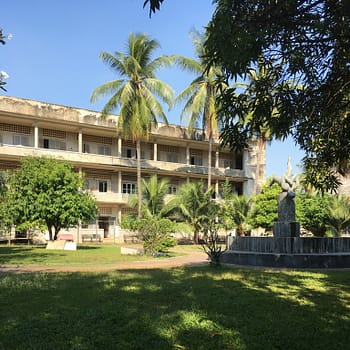He has sent me to bind up the brokenhearted, to proclaim freedom for the captives and release from darkness for the prisoners, to proclaim the year of the Lord’s favor and the day of vengeance of our God, to comfort all who mourn, and provide for those who grieve in Zion – to bestow on them a crown of beauty instead of ashes, the oil of joy instead of mourning, a garment of praise instead of a spirit of despair. – Isaiah 61:1-3 (NIV)
Traveling to new countries is both a privilege and, in my opinion, a necessity. For all those who are able, to see how another country lives – and suffers – is crucial in how we live our own lives. In so many places, history is a dark mistress who moves through daily life. As travelers, I believe we have an obligation to learn about countries and cultures on a deeper level. This is not always easy to do, especially during short trips. And when you can, oftentimes, it’s not fun. It’s hard and scary, dark and sometimes too-close-for-comfort. But that’s how it should be.
Below are some of my thoughts on my visit through Cambodia’s past. It’s a past that isn’t fun to think about but really isn’t that far behind us. I’ve included some pictures, and I encourage readers to approach this particular post with solemnity and care. This isn’t like most of the other writing on the blog, but it’s important that this experience is shared. Take care of yourselves. Take care of each other.
A Garment of Praise for a Spirit of Despair
Time has passed since our visit – almost six months. It’s hard to remember what we did and saw, yet, at the same time, it is still vividly impressed on my mind. Travel and memory are like that I suppose. Both present but also hiding, as if a haze hangs over my memory. It brings certain things to the forefront while others shrink back and hide in the shadows.
Before I talk about other Cambodian adventures, I feel it’s important to address a small piece of the country’s recent history and my very limited experience of it. The past lingers and affects all that we see and do on our visit. I only know a tiny bit about what happened here more than 35 years ago. I know it’s dark. And I know it can’t be ignored. But I also know our God is bigger than this darkness. I know He is redeeming all things. Even now is He is comforting those in Cambodia who grieve.
Even though we don’t visit the memorial sites where these terrible things happened until later in our trip, I feel it’s important to bring them up first. Vicki and I decide to visit two memorials on the same day. Not only is this the only full day we have free, but we want to give these important sites the proper attention.
A Dark History
Cambodia’s past, like all countries, has dark parts. One of the more recent events is the occupation and genocide of the Cambodian people by the Khmer Rouge. The Khmer Rouge took control of the Cambodian government in 1975. New government leaders had one goal – to turn the country into an agrarian communist “utopia”. Throughout the country, cities were forcibly emptied; people starved and abused in rural labor camps. During the four-year reign of the Khmer Rouge, up to one-quarter of Cambodia’s population is killed. Of the almost 2 million people who lost their lives during this time, as many as 60% were killed by direct execution.
The effects of the Khmer Rouge on Cambodian society are still visible even today. Landmines litter the country. Cambodia is one of the most heavily mined countries in the world. Every year, dozens of people are injured or killed due to unexploded landmines. And there are almost no old people here. During our nine days in Phnom Penh, I don’t remember seeing more than one or two people appearing to be over 70. Most people we encounter are children or adults appearing to be 50 years old or younger. Although we don’t bring it up, I imagine every person we meet – hotel staff, tuk-tuk drivers, waiters – all lost someone. Mothers, fathers, sister, uncles, grandparents, cousins. It’s hard to believe an entire generation of people, history, and experience is just gone.
Tuol Sleng
For our visit, Vicki and I start our remembrance walk at the prison, S-21, also known as Tuol Sleng. Tuol Sleng is one of 196 similar prisons operating throughout Cambodia during the Khmer Rouge. At the heart of Phnom Penh, and visited by thousands each year, S-21 is one of the most well-known prisons.
Our tuk-tuk driver drops us off at the gate, and we pay our $5 admission fee. From the very beginning, S-21 is sobering and hard. To walk on the same tiled floors where innocent people, beaten and bleeding, lie chained to their beds. To see the walls they leaned against, sitting on the floor of their cell, the area too small to lay down. There are still holes in the floor where long iron bars were attached, holding detainees to it by both their ankles. It’s hard to walk through places like that and imagine people existing there. It’s not living – living is a positive thing, and nothing about this place is positive. People lay here and wished for death.
Once a school, the grounds of Tuol Sleng were home to a much darker purpose for four years. From 1975-1979, it’s estimated these walls saw an astounding 15,000 prisoners or more. Functioning in secret, the prison housed “political enemies” of the Khmer Rouge. Many detainees confessed to their “crimes” under torture. No one, regardless of status, was safe. S-21 saw many employees and Khmer Rouge leaders as prisoners. In the end, only 12 of the detainees saw the liberation of Phnom Penh, and S-21, in 1979. Four of them were children.
Throughout my experience at S-21, I sense myself withdrawing and separating. In the face of so much evil, it’s easy to do, maybe even expected. But I want to be present here, to see and feel whatever comes. To bring myself back to why I’m here, I listen to the audio tour extras, the stories of survivors and brave enough to speak their experience. It’s hard to listen to, to be seeing a piece of what they saw. As a visitor and a foreigner, my feelings and experience will always be removed, different, and separated.
Vicki and I spend an unexpected two hours here, paying homage to those who suffered. We both listen to the entire audio tour. Superbly done, it is well worth the $3 rental fee. As we’re leaving, the narrator on the audio guide passes us a final thought. Today, we became keepers of history, holders of the past. It is now up to us to keep this from happening again.
The Killing Fields
Our sobering day continues as we take our rented tuk-tuk out to the now infamous “killing fields.” Riding in the half-open tuk-tuk on the highway, the wind whipping through our hair, it hits me that we are possibly driving the same route as the many who came before us. Except we are traveling in the daylight, in an open vehicle. Our eyes and bodies are unrestrained. We are visitors. We are not going to die.
The fields are altogether different than S-21. Years of wind and rain have washed away the blood that once stained the dirt. Some buildings and lean-tos, now removed, have plaques standing in their place. Being out in the open air, trees swaying in the breeze, somehow makes this area feel less menacing than S-21. It feels more sterile and distant, dare I say, even more peaceful. There’s water running through the property. But as Vicki and I make our way further into the memorial area, any feeling of peace and tranquility starts to fade.
The killing fields outside of Phnom Penh, known as Choeung Ek, are just one of 20,000 mass grave sites in the country. As the largest, it contains an estimated 129 graves; 49 of them remain completely intact. Today, it serves as a memorial site for the millions of people killed and buried without recognition. More than 9,000 bodies have been exhumed and categorized from the property.
Even still, more than 35 years later, pieces of clothing and bits of bone are working their way from the mass graves into the light. It’s as if the earth is surrendering these things slowly, begging the current generation to remain aware, to remember. Burial areas, scattered throughout the former orchard property, are marked and covered. Raised wooden walkways mark a path for visitors – to step off could mean you’re standing on a grave. Volunteers regularly comb the area, collecting the unearthed bits of the past to honor the dead.
One of the most striking and shocking areas is “the killing tree”. It’s here that my eyes, surprisingly for the first time all day, get misty. This tree, now hung heavy with woven and beaded bracelets, is where hundreds of children were brutally murdered. Even now I find it hard to swallow as I think about what happened here.
At the end of our tour, which was accompanied by an extensive audio commentary, is the memorial building. Inside, reaching what seems to be the full height of the building, are rows upon rows of glass cases. Inside are the carefully categorized remains of millions of people, given back to us by the earth over time. To move throughout the space is hard, emotionally and physically. The standing area in front of the cases is narrow and directly in front of the one shared entrance and exit. To move around the cases requires squeezing between posts supporting the building. I suppose the experience isn’t supposed to be comfortable.
Vicki and I leave the building in silence. We are emotionally and physically drained from the day.
Beauty from Ashes
Despite their dark past, the Cambodian people have not let it define who they are. The country and its people are recovering. The streets of Phnom Penh are no longer quiet and abandoned. They are once again crowded with tourists, families, cars, and shops. Throughout our nine-day visit, Vicki and I meet some of the most kind-hearted, helpful, open, serving people. Many of these same people directly felt the trauma of the Khmer Rouge. But they are not broken. There is work to be done everywhere; Cambodia is no different. It’s not perfect. But it is hopeful.
Despite the difficulty and heaviness of the day, I’m glad for the experience. To hold a piece of the world’s suffering is to, in a way, lessen the burden of those who experienced it. Spread out over many people, pain becomes more bearable. Terrible atrocities, shared with the world, weave our communal history ever deeper. Love, passed from one culture to another, lessens the distance between us. Carry your story into the world and carry the world’s story with you.

















this is your best writing yet